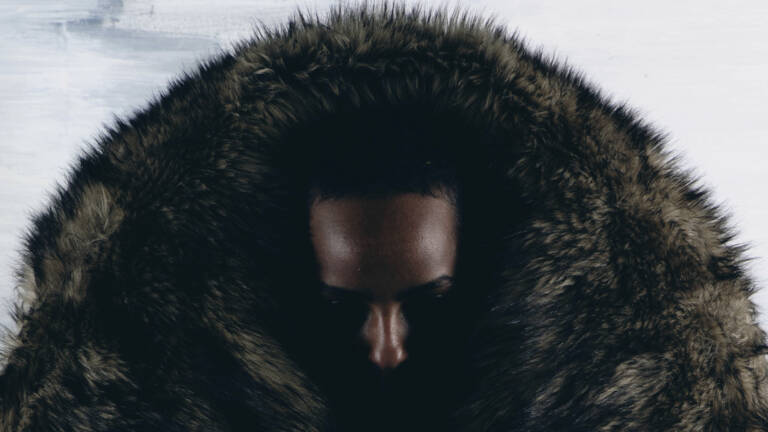


Bahamas-born/London based designer Traiceline Pratt graduated from Central Saint Martins M.A Fashion and has quickly emerged as a voice reshaping fashion’s future. With a résumé that includes working with Phoebe Philo and reimagining the iconic Dr. Martens 1460 boot in his own name, Pratt’s trajectory is anything but conventional. What makes him so compelling is not just his sculptural silhouettes or raw talent, but his refusal to play into fashion’s usual fantasies—insisting instead on a creative language rooted in memory, complexity, and truth. In this interview, we speak to Traiceline Pratt about growing up in the Bahamas, fashion’s obsession with nostalgia, building a new design lexicon, and what comes next from the second row to the front.
hube: You’ve talked about the importance of your childhood in the Bahamas and the role of those memories for keeping your work centred and authentic in an age you’ve deemed ‘monochromatic’. As you spend more time leading a life further from that time and place, how do you find your perspective of that period evolves? And do you think that transformation carries over to your work?
Traiceline Pratt: The concept of my work revolves around myself navigating life; past, present and future, and the people I come in contact with. The previous collection titled Beyond Verbal Communication that I debuted while at Central Saint Martins was a foundational layout for my creative language and a way of thinking.
Fast forward to today, my views on the fashion industry being ‘monochromatic’ comes from hearing the same fashion origin story. ‘My mum/grandmother was a seamstress and I loved seeing her dress up’, ‘Central Saint Martins was my dream school’, ‘My collection is a take on early couture fashion’ – these are monochromatic conversations and ideas in fashion to me.
I’m not saying that one shouldn’t have these ideas or starting points, but this isn’t something that is of interest to me. I knew nothing about CSM when I first applied, it wasn’t my dream to be the next creative director of a brand or even a fashion designer, no one in my family was a seamstress, and I didn’t holiday in the Swiss Alps which inspired me to create a collection that is a subversion of winter garments and old Balenciaga couture – blah blah blah.
My creative conversation will continue to grow as long as I’m alive – this is something that is ongoing and doesn’t have a specific start or ending. I would hope even after I’m long gone, some kid picks up where I left off and just keeps going – let’s call this five steps to the left way of thinking.
h: In an industry obsessed with novelty, what practices do you hope to preserve and what kind of reformation do you want to contribute to?
TP: This question is a very grey area for me, because after being in fashion for a few years, I find that the purists in fashion use words like preserve as a way to keep someone with different views out. While I do have a high respect and appreciation for things such as the making of couture garments and its craftsmanship, I also stand on the side of the tourist who comes in with radical approaches to fashion as well. I mean, at one point, ready-to-wear would have been considered a novelty in a time where made-to-order or couture was in its prime. I say this to say, there can be appreciation for both and they can co-exist – I’m not afraid for today to end and tomorrow to come.
h: Before entering fashion, you had a background in fine arts. For you, where do the two meet and how do they influence one another both as inspiration and in practice?
TP: They both meet at the corner of urgency and relevancy. Art has taught me how to be a reflection of the times you as the artist live in, while fashion has taught me a lot of the past and how it can still be useful.
h: Oftentimes, we give the label ‘fast rising’ to talents that in fact have been persevering behind the scenes for a long time; as this label is now being assigned to you, how would you define your own career trajectory so far? Where would you like to see it go next?
TP: I’ve been around the creative industry for some time now. I’ve also been in luxury fashion and accessories for more than 10 years behind the scenes. It’s just that I’ve taken a step forward from the individual behind the scene to the one second row from the front to the left. I don’t speak about it much as I feel fashion on the design side weaponises years and accolades as a way to block talent. If ever in an interview or any sort of creative conversation, I lead with my work and almost never with my CV.
Next for me is to move from the second row to the front row and put more work and ideas forward.
h: Your designs were recently worn by this year’s Met Gala co-host, and rapper, A$AP Rocky. Could you share how this collaboration came to be and what impact it has had on the development of your brand?
TP: The project was something I was extremely grateful for and appreciative of Matthew Henson trusting in my talents and ideas. The work came naturally, where it was just Matthew showing love and support for the clothes that I released after my London Fashion Week presentation under CSM. Fast forward months after initially speaking and him being more of a big bro to me and encouraging me, he asked if I would be interested in doing some work together.
I showed him designs that I was currently working on – he loved them all – and from there, I woke up and saw A$AP Rocky on the Seth Meyers show, which was such a big moment for me.

